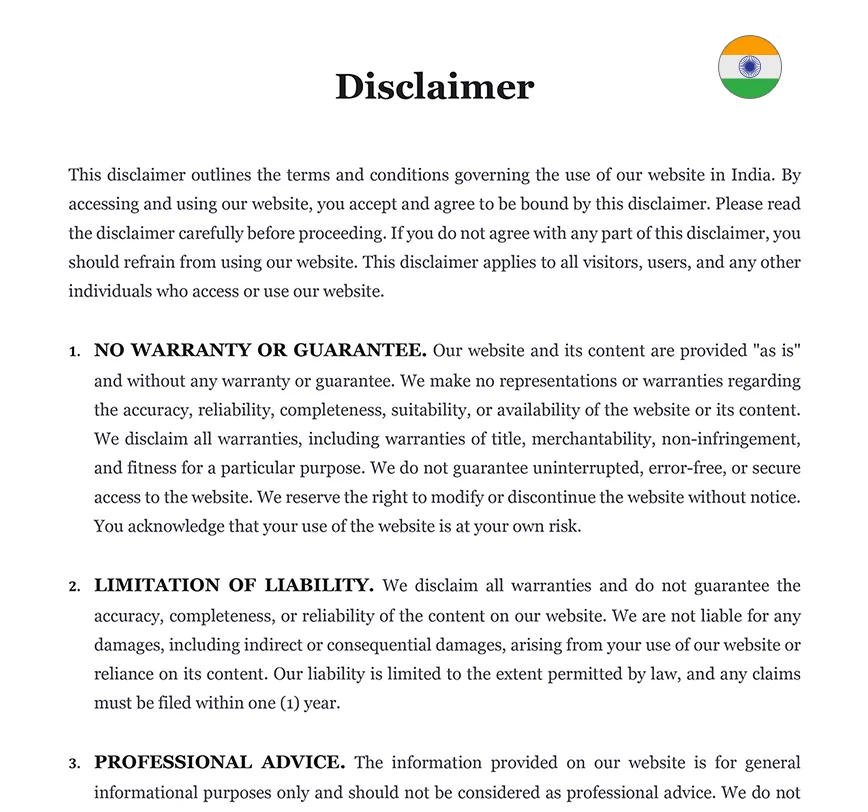Ready to use legal template
Drafted by experienced lawyers
Compliant with Indian law
Ready to use legal template
Drafted by lawyers
Compliant with Indian law
Home › Intellectual property › Disclaimer
Learn more about Website Disclaimer in India
A Website Disclaimer in India is a legal statement that informs users about the terms and conditions of using a website and limits the liability of the website owner. It explains the purpose of the website, disclaims warranties, clarifies the accuracy of information provided, and outlines any third-party content. The disclaimer protects the website owner from legal claims and helps manage potential risks associated with the website’s content. It is crucial for businesses in India to have a well-drafted Website Disclaimer to ensure legal compliance and mitigate potential liabilities.
Table of contents
-
What is a Disclaimer and why is it important?
-
What should be included in a Disclaimer agreement?
-
How can a Disclaimer protect businesses from liability?
-
Are Disclaimers legally binding in India?
-
What are the key elements of an effective Disclaimer?
-
How should Disclaimers be displayed and communicated to users?
-
Can Disclaimers be customized for different types of businesses or industries?
-
What are the legal implications of not having a Disclaimer in place?
What is a Disclaimer and why is it important?
A Disclaimer is a legal statement that is used to limit or exclude certain liabilities or risks. It serves as a notice to inform users or customers about the limitations, disclaimers, and terms of use associated with a product, service, or information provided by a business or individual.
In India, Disclaimers are of significant importance as they help protect businesses and individuals from potential legal disputes and liabilities. They establish clear boundaries, communicate the terms and conditions of use, and inform users about any potential risks or limitations involved.
A well-drafted Disclaimer can help manage expectations, reduce legal risks, and protect the rights and interests of the business or individual. It sets forth the rights and responsibilities of both parties, ensuring transparency and promoting fair practices.
By including a Disclaimer, businesses and individuals can clarify the scope of their services, disclose any potential risks, and limit their liability in certain situations. This not only safeguards their interests but also helps in establishing trust and credibility with users or customers.
Overall, a well-crafted and properly implemented Disclaimer is an essential legal tool that helps protect the rights, mitigate risks, and establish clear guidelines for the use of products, services, or information provided by businesses or individuals in India.
What should be included in a Disclaimer agreement?
In a Disclaimer agreement, there are several important elements that should be included to ensure its effectiveness and clarity. These elements may vary depending on the specific context and purpose of the Disclaimer, but generally, the following points should be addressed:
➤ Clear Identification: Begin by clearly identifying the parties involved, such as the business or individual providing the information, product, or service, and the users or customers accessing or using it.
➤ Scope and Limitations: Clearly define the scope of the Disclaimer and specify its limitations. Explain what is covered and what is not covered by the Disclaimer, including any specific exclusions or exceptions.
➤ Purpose and Use: Clearly state the purpose of the information, product, or service being provided and outline how it should be used. Specify any intended or recommended uses, as well as any prohibited or restricted uses.
➤ Risks and Assumptions: Disclose any potential risks associated with the use of the information, product, or service. Clearly state any assumptions made and any prerequisites or conditions required for the proper use or effectiveness of the provided content.
➤ Liability and Indemnification: Address the extent of liability of the business or individual providing the information, product, or service. Include a disclaimer of liability for any damages, losses, or injuries arising from the use of the content. Outline any indemnification provisions, if applicable.
➤ Legal Compliance: Specify that users or customers must comply with applicable laws, regulations, and terms of use. Clarify that the provided content does not constitute legal advice and that users should seek professional advice when necessary.
➤ Modifications and Updates: Reserve the right to modify or update the Disclaimer agreement as needed. Specify how users will be notified of any changes and their continued acceptance of the Disclaimer through their use of the content.
➤ Governing Law and Jurisdiction: Specify the governing law and jurisdiction that will apply to the Disclaimer agreement, ensuring it is consistent with Indian laws and regulations.
By including these essential elements, a Disclaimer agreement can provide a clear understanding of the terms, limitations, and responsibilities for both the business or individual providing the information, product, or service and the users or customers accessing or using it.
How can a Disclaimer protect businesses from liability?
A Disclaimer can protect businesses from liability by clearly stating the limitations and exclusions of responsibility. It can inform users that the business is not liable for any damages, errors, or inaccuracies in the information provided on the website. By setting forth the terms and conditions of use, the Disclaimer helps establish the boundaries of the business’s responsibility and communicates to users that they engage with the website at their own risk. This can help shield the business from legal claims and potential liabilities arising from user interactions with the website’s content or services.
Are Disclaimers legally binding in India?
Disclaimers can be legally binding in India if they are properly drafted and meet the necessary legal requirements. While there is no specific legislation governing disclaimers in India, their enforceability is generally based on contract law principles.
For a Disclaimer to be legally binding, it should:
➤ Clear and Unambiguous Language: The language used in the Disclaimer should be clear, unambiguous, and easily understandable by the users. Ambiguous or confusing disclaimers may not be considered legally effective.
➤ Notice and Awareness: The Disclaimer should be prominently displayed and easily accessible to users. It should be brought to the attention of users before they engage with the product, service, or information, ensuring that they are aware of its existence and contents.
➤ Voluntary Acceptance: Users should be required to explicitly accept the terms of the Disclaimer, such as by checking a box or clicking an “I agree” button. This demonstrates their voluntary acceptance of the terms and conditions outlined in the Disclaimer.
➤ Compliance with Applicable Laws: The Disclaimer should be in compliance with relevant laws and regulations in India. It should not seek to limit or exclude liability for actions that are prohibited by law.
➤ Reasonableness: The terms and provisions of the Disclaimer should be reasonable and fair, striking a balance between protecting the interests of the business and the rights of the users.
It is essential to consult with legal professionals to ensure that the Disclaimer is drafted in accordance with Indian laws and tailored to the specific requirements of the business. They can provide guidance on the language, placement, and enforceability of the Disclaimer to maximize its effectiveness in providing legal protection.
What are the key elements of an effective Disclaimer?
An effective Disclaimer should include key elements to provide clarity, transparency, and protection for businesses. Here are the key elements that should be considered:
| ➤ Clear and Unambiguous Language: The language used in the Disclaimer should be clear, precise, and easily understood by the target audience. It should leave no room for ambiguity or confusion. |
| ➤ Scope and Limitations: The Disclaimer should clearly define the scope of its application and outline the specific areas to which it applies. It should specify the limitations of liability, clarifying what the business is and is not responsible for. |
| ➤ Risks and Assumptions: The Disclaimer should clearly state any risks associated with the use of the product, service, or information provided. It should also outline any assumptions made by the business regarding the user's knowledge, skill, or responsibility. |
| ➤ Exclusion of Liability: The Disclaimer should clearly state any exclusions or limitations of liability, including circumstances under which the business will not be held responsible for any damages, losses, or claims arising from the use of its products or services. |
| ➤ Severability Clause: It is advisable to include a severability clause, which states that if any provision of the Disclaimer is found to be invalid or unenforceable, the remaining provisions will still be valid and enforceable. |
| ➤ Governing Law and Jurisdiction: The Disclaimer should specify the governing law and jurisdiction in which any disputes arising from its interpretation or enforcement will be resolved. |
| ➤ Regular Updates: It is important to include a clause that allows for periodic updates or modifications to the Disclaimer as necessary, ensuring that it remains up to date and aligned with changing circumstances or legal requirements. |
| ➤ User Acknowledgment: The Disclaimer should include a statement in which the user acknowledges that they have read, understood, and agreed to the terms and conditions outlined in the Disclaimer. |




